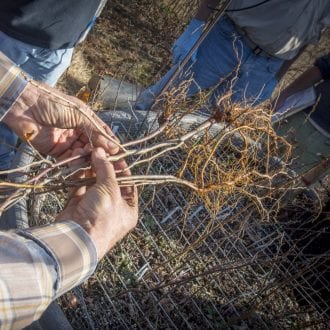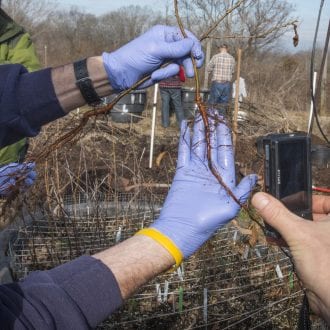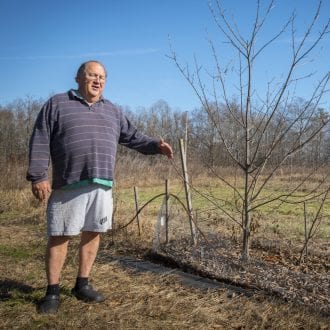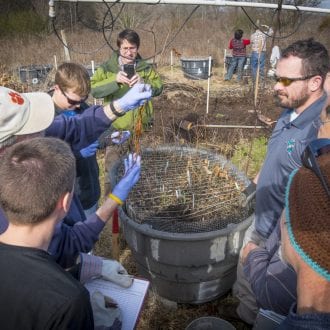CLEMSON, South Carolina – In the eastern United States, wherever you see a pine or an oak tree today there likely was a chestnut tree in the 19th century. American chestnut trees once ruled the forests, growing to 100 feet. It was prized for lumber because its grain was straight and it was rot-resistant, and chestnuts were part of the diet for people and animals.
Then the blight struck. From about 1904 to the mid-1950s, a parasitic fungus, Cryphonectria parasitica, killed nearly all the American chestnut trees and blight became the focus of intense research.
But in the South, another chestnut killer went largely unnoticed. Phytophthora cinnamomi, a fungus-like microorganism in a group called Oomycetes, exists in soil about as far north as the Mason-Dixon line, according to Steve Jeffers, a plant pathologist and a leader in restoring the American chestnut. This pathogen causes a disease known as Phytophthora root rot.
“It doesn’t matter how much blight resistance the tree has. If there’s Phytophthora in the soil, the (chestnut) tree will die,” said Jeffers, a professor in plant and environmental sciences in Clemson’s College of Agriculture, Forestry and Life Sciences.
Phytophthora cinnamomi is sensitive to cold temperatures, but it’s slowly creeping northward. With global warming, the problem will only become worse, said Joe James, a retired orthopedic surgeon and one of the American chestnut’s most ardent supporters.
West of Clemson’s campus in Oconee County, in the community of Return, James runs Chestnut Return Farm, a personal project, with help from Clemson University and volunteers from The American Chestnut Foundation (TACF). James sounded the clarion call about Phytophthora root rot in 2003 when hybrid chestnut seedlings planted at his farm started dying.
But blight had become such a prominent nemesis, people had forgotten about root rot and didn’t immediately believe James’ story. Now, researchers and students from Clemson are helping James select chestnut trees for resistance to Phytophthora root rot.
At a farm in Meadowview, Virgina, the TACF grows hybrid trees, a cross between the Chinese chestnut, which is resistant to blight and Phytophthora, and the American chestnut. Then the trees are backcrossed with an American chestnut parent tree to eliminate genes from the Chinese tree and produce trees that are genetically more like the original American chestnut parent.
At Chestnut Return Farm, the roots of these hybrid seedlings are exposed to Phytophthora cinnamomi in an annual field trial that has been conducted for 13 consecutive years. Trees that are resistant have a healthy bundle of roots, almost as long as the seedling itself. Trees that are not have very few healthy roots and lots of dead, decayed roots.
In an earlier Clemson article, James said, “I’m often asked why I feel so passionate about the American chestnut tree. There are obvious reasons, of course. The trees were huge, beautiful and extremely useful to those who lived within their range. But to me, the main reason is that the demise of the chestnut left a big hole in our ecological food chain. Just about every animal ate chestnuts, including humans. I can’t overestimate the damage caused by the loss of this invaluable food source.”
- A volunteer holds chesnut tree saplings that were pulled to examin their root systems for phytophthora cinnamomi at the Chestnut Returns Farm in Oconee county, S.C., Jan. 12, 2017. (Photo by Ken Scar)
- Clemson University students examine the roots of a chestnut tree sapling at the Chestnut Returns Farm in Oconee County, S.C., Jan. 12, 2107. (Photo by Ken Scar)
- Dr. Joe James at his Chestnut Return farm in Oconee county, S.C. (Photo by Ken Scar)
- Clemson University students examine chestnut tree saplings at the Chestnut Returns Farm in Oconee county, S.C., Jan. 12, 2017. (Photo by Ken Scar)
- Students and volunteers examine chestnut tree saplings at the Chestnut Return farm in Oconee county, S.C., Jan. 12, 2017. (Photo by Ken Scar)
- Clemson University students and civilian volunteers look at the roots of a chestnut sapling at Chestnut Returns Farm in Oconee county, S.C., Jan. 12, 2107. (Photo by Ken Scar)






